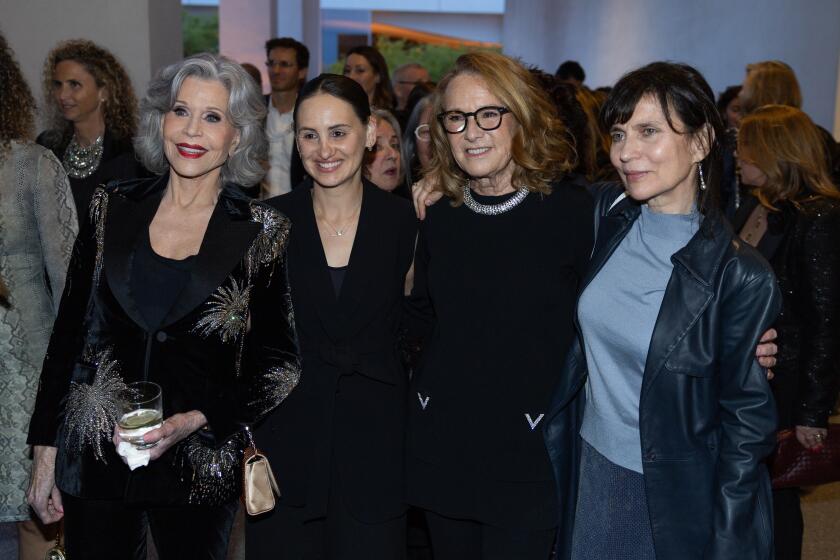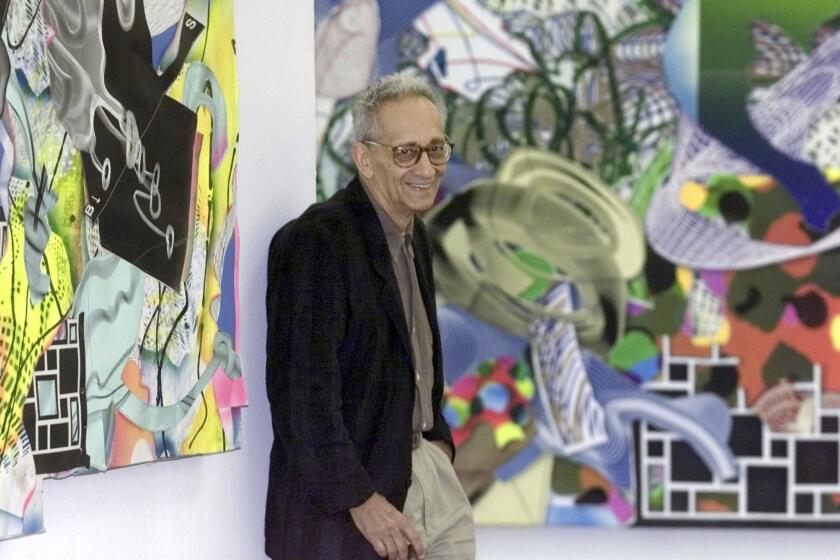Hot Bods, Summer in the City
“Where seldom is heard,
An articulate word.
And the boys are all beefy
But fey.”
These quaintly comic lyrics of “Welcome to WeHo,” a satirical poke at L.A.’s gay mecca of West Hollywood, can be heard at the Hudson Theatre in Hollywood in a new revue, cleverly if somewhat inevitably titled “Bed, Boys & Beyond.” Five handsome, buff young guys move deftly upon a minute corner stage and celebrate, bemoan, protest and berate the experiences, trials and tribulations of being a gay man in modern urban America.
American audiences often seem to applaud the intention of a cultural enterprise rather than its execution, and the night I went, this show appeared to have the overwhelmingly gay male crowd in the palm of its hand from the get-go. Its intentions were so honorably politically and emotionally correct, and so seemingly tuned in to the audience’s own preoccupations, that the reception was predictably loud and enthusiastic.
“Mr. Right,” “Dance at the Gym,” “Cruising & Schmoozing”--the titles summoned up a supposedly universal gay search for love, sex, affection or all three. Along with this, the obsession with appearance and the gym is ridiculed, as you might expect (albeit by five immaculate and very fit-looking young actors) and there is the obligatory plaintive cry for tolerance.
But some of the songs also had a real and particular resonance with this L.A. audience. The gist of “Welcome to WeHo” was that, for its happy clappy residents, those guys with faces unclouded by excessive thought, there was no earthly reason any sensible gay man would want to venture beyond WeHo’s borders when he has everything gay that he could possibly want or need at his fingertips: great friends, great boyfriends, great gyms and great coffee.
The general laughter of recognition in the audience tallied with my and my friends’ experience. But were the boys on the stage at the Hudson really accurate portrayals of the guys I see every day on the streets and in the bars?
For many gay men all over the world, West Hollywood has come to symbolize some kind of ultimate gay glamour, and was certainly famous enough in my hometown of London for us to get the jokes of Joan Rivers (“What separates the men from the boys? In West Hollywood, that’s a crowbar”).
It’s no great surprise that gay men visit the city in the thousands; for them the California surfer-jock look is the ultimate desire-object and makes the place a natural destination. Much of what informs gay lifestyle in European cities draws its inspiration from WeHo: The current fashion for hairless, glistening, muscled bodies (“ripped” in the current parlance) is essentially an L.A., a WeHo, thing.
However, when I first visited in 1993 the alternative Strip--that stretch of Santa Monica Boulevard between La Cienega and Doheny--I was disappointed. It seemed provincial, the clubs and bars looked surprisingly sleazy and bereft of the hunks of the promised land.
So, instead, I found myself spending most of my time at a sweet little outdoor coffeehouse called the Abbey near Santa Monica and Robertson. It was relaxed, quiet and relatively uncruisy. It served the best desserts I’d seen in this dessert-less city and played a civilized mixture of piped music. It felt like having tea on somebody’s front patio and was anything but hardcore.
Now, in the summer of 2001, the Abbey is enjoying its recently acquired status as one of the hottest gay venues in the city; indeed, it’s famous enough to be mentioned in “Welcome to WeHo.”
On the weekend nights, when more than 400 of the city’s finest pack in there, there are impressively long lines and the obligatory morose-looking guy checking IDs at the entrance. Instead of being just a meeting point from which the guys sort out their evening’s entertainment, it has become a destination in itself.
They’re not just coming for coffee and cake anymore. Essentially, the Abbey has transformed itself by adding cocktail bars and hugely extending its outdoor patio area. The garden statues and little fountains remain, but the area has been virtually doubled. It has installed a row of desperately fashionable cabanas at the back for louche Romanesque sprawling. It has changed its fixtures and fittings, establishing a decorative style which could be termed Disposable Quality; if Pottery Barn had been asked to come up with a gay bar, it would look like the Abbey.
Add to this a reputation for its range of somewhat expensive but superb martinis mixed by bartenders who seem to have been genetically modified for looks, and the place has managed in the process to create something in line with the desires and aspirations of the more social, visible part of gay L.A.
And visibility is an important part of it. The Abbey is still quite unusual in that it is completely open to the street.
“We are proud to be visible,” says Saul Santos Aldana, manager for the last five years. “Gay men no longer want to be hidden behind doors.”
Originally from Guatemala, Aldana has been in L.A. for 15 years and has seen the scene change totally. “Clubs are very flat now,” he says. “There are no hot places.”
While admitting that West Hollywood has a reputation for being “stuck up,” Aldana is nevertheless proud that his bar attracts an affluent crowd, and even the occasional celebrity--apparently Julia Roberts made an appearance here a year or so ago. And on any day, there are a fair number of women, certainly not all gay.
Whether it has a sexy atmosphere is another matter--maybe the new visibility, the lack of a covert sensuality, actually takes away a bar’s sex appeal. And the constantly thudding dance music seems to be playing to itself in a vacuum, as there isn’t anyone here who’s about to get up and start dancing. This is very much a place where your eyes do most of the moving, as you stand and sip your apple martini.
But it is the men who are most important, of course. “Bed, Boys & Beyond” had parodied the preening tyranny of appearance, the preoccupation with getting the perfect look of the gay scene. On a crowded Saturday night at the Abbey, there is the feeling, crucial for a successful venue, that here indeed is to be found the best-looking and most eligible crowd in town. The most ripped--the muscle boys--are literally at center stage, in the middle of the patio, by the outdoor bar.
Fashionably yet somewhat identically dressed--the three-quarter-length pants a la Jude Law in “The Talented Mr. Ripley” seem to be de rigueur at the moment--these guys are just the right shade of tan, with improbably white teeth and pectoral muscles which seem to have a life independent of their owners. These guys don’t so much move as position themselves.
As with all “trickle-down” effects, the rest of the crowd, the majority, are in shape to varying degrees, but there’s no denying who sets the standards. “Five percent body fat,” answers one campy, short, stocky guy when I ask what he and his friends think gay men are most looking for in WeHo.
Aldana insists that the crowd is very mixed in terms of age, though undoubtedly 20-and 30-somethings predominate.
Since being in L.A., I have heard constant protests at the particular ageism of the scene here. “There’s no question that at my age you’re virtually invisible in the gay world,” complained one 60-year-old friend, a guy who goes to the Abbey, among other places, from time to time but takes a good 10 years, at least, off his age when he crosses the threshold. “I would get more recognition if I were dying from AIDS,” he said.
Here, as with other gay bars, I can’t help but feel that the presence of older men works more to simply flatter the younger ones in their aspirations to be broad-minded and inclusive.
What is indisputable, however, is that the crowd doesn’t fully reflect the city. Looking around at the hundreds of guys packed together on the evenings I was there, I certainly saw Asians and Latinos but only a handful of African Americans.
The segregation of L.A. is evident in the gay scene of West Hollywood, where the accepted standard of desirability for the whole gay world--smooth, chiseled, muscled, white--largely originates, whether it admits it or not. One black guy who said that he rarely goes to West Hollywood told me, “If there is racism, then it don’t bother me. But I’m not gonna be some guy’s fantasy for the night.”
Stage and reality pretty much coincided therefore, albeit that one-fifth of the cast of “Bed, Boys” is black and, thus, quite different than the cast at the Abbey. But what was also true of both was the absence of a big issue about which gay men could become passionate.
If anything, from my conversations and observations, the general tone of gay life seems to be increasingly conservative and introspective, not to say self-absorbed. The gentrified, affluent and self-assured tone of the Abbey suits this well. As Aldana said, there is the sense that things are, overall, going well for gays.
The fight for legally recognized marriage ceremonies, or the ability to adopt children--the only real issues which were cited to me by Abbey patrons as being of the moment--are ones which are, if you like, proactive, and lack the immediacy of an outright, active attack on the gay world about which one could take up arms.
In one important way, such desires are really quite traditional, about further infiltration into mainstream society. One guy at the bar made constant and somewhat insistent references throughout our conversation to his “husband”; the pride and deference he showed in using the term could have placed him in the Eisenhower era.
Subjects such as drug and steroid abuse, or the apparent increase in the alarming practice of “barebacking”--anal sex without condoms--remain, it seemed, more or less not talked about. Instead, the main preoccupation seems to be with relationships and the never-ending, same old, same old search for Mr. Right.
“Mr. Right, or Mr. Right Now,” proclaimed one guy in his early 20s, with that put-on air of world-weariness common among the inexperienced. “That’s all people are worried about. There’s a false complacency.” In this respect, the gay world this summer is right up there in the mainstream zeitgeist of “Sex and the City,” a TV show which numbers gay men among its most avid fans.
“They get stuck in this pattern of always looking for something better. You want the even better-looking guy, who’s got the better body
Most of the conversations I had with friends, acquaintances and even strangers get around to this subject sooner or later, as indeed they do when one meets with straight single friends in their 20s and 30s. However, whereas “Bed, Boys & Beyond” portrayed sweetly sensitive, vulnerable guys who simply wanted to fall in love, the sense I got at the Abbey was of sweetly sensitive, vulnerable guys who simply wanted to fall in love with a Calvin Klein model.
Los Angeles is not America; this is a gayer city than most, and maybe has cause to be complacent in that it is probably one of the most privileged. Nowhere else is there such a sense of gay success and achievement at the highest levels. Whether or not the “velvet mafia” really exists, it’s the case that with figures such as David Geffen at the top of the tree, the L.A. role models for gay men are world-class.
But if my nights at the Abbey were any guide, then the cautious, overridingly banal observations of the revue show were also, as it turned out, pretty much on the money. Perhaps we are in a lull before some kind of storm. Perhaps everybody really does love us too much now. Either way, next time we’re dramatized, it would be nice if we really had something to write home about.
More to Read
The biggest entertainment stories
Get our big stories about Hollywood, film, television, music, arts, culture and more right in your inbox as soon as they publish.
You may occasionally receive promotional content from the Los Angeles Times.






